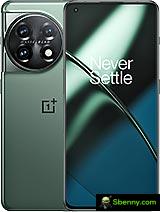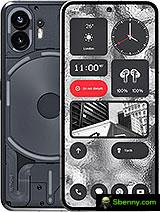introduzzjoni
There was a time, not too long ago, when OnePlus was a small underdog trying to make it into the smartphone realm. It successfully revolutionized the market with competitive products and grew from there. Well, not without the help of the BBK company, but it’s still an underdog success story.
Today Carl Pei, one of the co-founders of OnePlus, is trying to repeat his success in this field by developing the Nothing brand. After the relative success of the original Nothing Phone (1), the company is now launching a second model on the market: the Nothing Phone (2).
The latter is a significantly more premium offering than the original. So much so that it can now successfully compete with other high-end devices. It’s also one of the few newcomers to the US market, where it’s priced similarly to the OnePlus 11. Each has its own pros and cons, which are worth looking into.
You can compare the full spec sheets or check out our editor’s rating further down.
Paragun tad-daqs

OnePlus
11
163.1 x x 74.1 8.5mm
(6.42 x 2.92 x 0.33 pulzieri)
The two phones are very similar in size and weight. Both technically feature identically sized 6.7-inch 20:9 displays, but differ significantly in shape. In fact, the panel of the OnePlus 11 is curved, while that of the Nothing Phone (2) is flat. This allows the OnePlus 11 to have a higher screen-to-body ratio of around 89.7%, compared to around 87.2% on the Nothing Phone (2), and thinner display bezels.
Whether or not this results in a more comfortable and ergonomic design is something of a personal preference. The OnePlus 11 is much rounder on all sides, which ensures a comfortable feel when holding it. In contrast, the Nothing Phone (2) is much more boxy with a distinctive iPhone-inspired look and silhouette.
In terms of construction and materials, the two phones are once again similar. Both boast premium materials with glass on the back and front and an aluminum central frame. However, the OnePlus 11 has a clear advantage in this category, as it offers a higher IP64 rating than the IP54 of the Nothing Phone (2).
The OnePlus 11 also boasts Gorilla Glass Victus on the font and Gorilla Glass 5 on the back, which inspires a little more confidence than the unnamed version of Gorilla Glass on the Nothing Phone (2).
Ara l-paragun

OnePlus
11
LTPO3 fluid AMOLED
120Hz
1440 × 3216
pixels
525
ppi
As we have already mentioned, the two phones have technically identical display diagonals and aspect ratios. However, the panels themselves differ significantly in practice as the one on the OnePlus 11 is curved, while the Nothing Phone (2) has a flat display.
Let’s talk about other similarities. Both displays offer 10-bit color and hardware support for HDR10+ video. The OnePlus has the advantage here too with Dolby Vision certification.
On the other hand, the Nothing Phone (2) has an advantage in terms of maximum display brightness, according to our tests. A brighter display is not only more comfortable to use in difficult lighting conditions (not that both phones don’t have enough to cover it), but it also goes a long way towards ensuring a good HDR experience.
Speaking of a good viewing experience, we were very impressed with the color accuracy of both phones. You can expect near-perfect sRGB and DCI-P3 colors from them.
While the two displays are a no-brainer in the color department, there’s no competition when it comes to resolution. The OnePlus 11 clearly has the advantage with its 1440 x 3216 pixel QHD panel. This results in a surprisingly sharp pixel density of around 525 ppi. However, it’s not that the Nothing Phone (2) isn’t perfectly sharp either, with its FullHD+ 1080 x 2412 pixels and 394 ppi.
Both phones support a 120Hz refresh rate. However, there are some notable hardware and software differences in how each handles the high refresh rate. It’s great that both phones use LTPO technology, which allows them to change the refresh rate more dynamically and granularly. That said, using its superior LTPO3 technology, the OnePlus 11 beats the Nothing Phone (2) with much more dynamic refresh rate switching.
Battery ħajja
The two phones have a similar battery capacity with a slight advantage for the OnePlus 11 at 5,000 mAh, compared to 4,700 mAh for the Nothing Phone (2). This difference in capacity translates into a rather expected and equally small difference in actual battery life.
The OnePlus 11 technically beats the Nothing Phone (2) in the battery department, although not actually by much, scoring 108 hours of battery life, compared to the Nothing Phone (2)’s 103 hours.
Veloċità tal-iċċarġjar
The two phones are quite different in terms of charging support. OnePlus 11 definitely has an advantage in terms of charging speed. Its international version is capable of charging at up to 100W PD, while the US one is limited to 80W. In our tests, it performed very well, taking just 22 minutes to go from zero to one hundred percent battery. It’s also worth noting that the OnePlus 11 comes with its own 100W charger included in the box.
The Nothing Phone (2) may only be able to charge 45W PD in comparison, but it’s still a relatively fast charging device in the grand scheme of things. Thirty minutes on an appropriate charger took the phone from zero to 62 percent, and a full charge took just over an hour in our testing. Unfortunately, the Nothing Phone (2) doesn’t come with a charger included; you need to purchase one separately.
On a more positive note, the Nothing Phone (2) probably has the most versatile charging setup, including support for up to 15W wireless charging, which the OnePlus 11 can’t do, as well as 5W reverse charging.
Ittestja l-kelliema
Both phones have a stereo speaker setup. Both also use a hybrid stereo setup with a front-facing amplified earpiece that doubles as a second channel. Both the Nothing Phone (2) and the OnePlus 11 earned a “VERY GOOD” noise rating in our tests, with the Nothing Phone (2) slightly ahead, but not by much.
Both devices have pretty clean audio output, mostly focused on good mids, as expected. Neither phone disappointed in terms of highs and lows. We’d say both phones are comparable when it comes to speakers.
In case you were wondering, neither phone has a 3.5mm audio jack.
Prestazzjoni

OnePlus
11
Snapdragon 8 Ġen 2
4-il mil nawtiku
8GB / 128GB
konfigurazzjoni bażika
Both phones are based on flagship chipsets, but the Nothing Phone (2) features the slightly older Snapdragon 8+ Gen 1 chipset. It’s still a flagship chip, which is what many fans of the original Nothing Phone (1) wanted to see from the company. The Snapdragon 8+ Gen 1 on the Nothing Phone (2) is a toned down version of the original chipset with lower clock speeds on all three core clusters. The main Cortex-X2 core is clocked at 3.0 GHz (instead of 3.2 GHz), the 3x Cortex-A710 cluster runs at 2.5 GHz (instead of 2.75 GHz), and the 4x Cortex-A510 cores highly energy efficient they operate at 1.8 GHz. (instead of 2.0 GHz). This should reduce overall energy demand. The chipset is still based on TSMC’s 4nm production node and relies on the Adreno 730 GPU for graphically demanding tasks.
The OnePlus 11 is based on Qualcomm’s flagship chip from 2023: the Snapdragon 8 Gen 2 (4 nm). It’s a noticeably more powerful chip than the Snapdragon 8+ Gen 1, even on paper, with a CPU configuration consisting of a 3.2GHz Cortex-X3 main core, two 2.8GHz Cortex-A715s, two Cortex-A710s 2.8 GHz and three 2.0 GHz Cortex-A510. The bundled GPU is an Adreno 740. All this is paired with fast LPDDR5X RAM and UFS 4.0 storage (except in the base 128 GB variant, which is UFS 3.1).
You can get both phones with as little as 128GB of storage and 8GB of RAM. The Nothing Phone (2) increases RAM to 12GB in the highest storage tiers, while the OnePlus 11 can be found with up to 16GB of RAM.
We would probably opt for the 256GB variants of both devices. However, there are notable differences between the two, namely that the OnePlus 11 uses faster UFS 4.0 storage than the Nothing Phone’s (2) UFS 3.1. It’s worth noting that neither device has expandable storage, so you get as much as you need on board.

Xejn
Telephone (2)
AnTuTu 9
895,434
5 Geekbench
1,240 qalba waħda
5 Geekbench
3,957 multicore

OnePlus
11
AnTuTu 9
1,140,661
5 Geekbench
1,150 qalba waħda
5 Geekbench
4,899 multicore
As expected, the OnePlus 11 is the noticeably more powerful device of the two. That said, the Nothing Phone (2) is definitely not short on power. Even though it’s downclocked and clearly optimized for efficiency first and foremost, it still has enough power to tackle everyday tasks with ease. Gaming is also no problem, although the Adreno 740 in the OnePlus 11 is significantly more powerful than the Adreno 730 in the Nothing Phone (2).
Paragun tal-kamera
Both phones have pretty powerful camera setups, with a 50MP camera as the primary camera.
Let’s start with Nothing Phone (2) first. The main camera is based on a 1/1.56″ Sony IMX890 sensor with 1.0 µm pixels, paired with an optically stabilized 23mm f/1.88 lens. The camera supports PDAF and can capture video up to 4K at 60 fps. Another 50 MP camera completes it – an ultrawide that supports autofocus and can focus up to 4 cm away. At the front we find a 32MP camera with fixed focus.
The OnePlus 11 probably has the most versatile camera setup between the two phones. The main camera uses the popular 50 MP, 1/1.56″ Sony IMX890 sensor paired with an optically stabilized 24mm lens and a large f/1.8 aperture. It can capture video up to 8K at 24 fps. ultrawide camera uses a 48 MP sensor and There is then support for autofocus to allow close-ups and macro photos, then there is also a dedicated 32 MP, 2x telephoto lens, which OnePlus markets as a portrait-focused camera, while the selfie cam is a 16MP unit with fixed focus.
To summarize, both phones use the same 50MP Sony IMX890 main camera and very similar ultrawides with autofocus for macro shots. The OnePlus 11 offers an extra telephoto lens, while the Nothing Phone (2) has a high-resolution selfie.
Both phones capture beautiful photos in daylight with good details and colors.



No Phone (2): 0.6x • 1x • 2x
Additional samples and a detailed analysis can be found in our Nothing Phone (2) review.



OnePlus 11: 0.6x • 1x • 2x
Additional samples and a detailed analysis can be found in our OnePlus 11 review.
Both phones offer very competent 2x zoom shots. The OnePlus 11 clearly has the advantage here with its optical zoom camera. Even so, 2x shots taken with the Nothing Phone’s main camera (2) hold up quite well. We can see that this isn’t a simple crop and a layer up, but that it’s likely coming from the center of the camera’s 50MP full-resolution output.
Despite the disparity in selfie resolution, both phones also offer competitive selfies.
Both phones manage to shine well even in low light conditions, as expected.


No Phone (2): low light • night mode


OnePlus 11: low light • night mode
All in all, neither phone will disappoint in the camera department, as both camera setups are solid, but the OnePlus 11 probably has a slight edge.
Here’s a glimpse of how the Nothing Phone (2)’s main camera compares in terms of image quality to that of the OnePlus 11 in our image comparison tool.
And here’s how the Nothing Phone (2)’s main camera compares in terms of video quality to that of the OnePlus 11 in our video comparison tool.
verdett
Looking at the two devices side by side, it’s easy to assume that the OnePlus 11 is the better one, which could also be true from a purely hardware point of view. The OnePlus 11, however, isn’t necessarily the best value proposition of the pair. After all, it sells for a slightly higher price on average than the Nothing Phone (2). At the time of writing, the MSRP is around $670 for a 256GB + 16GB unit in the US for the Nothing Phone (2) and $650 for the OnePlus 11 (256GB + 16GB). In the EU, the difference is much larger: around €660 for the same Nothing Phone (2) and €900 for the OnePlus 11. Prices in the UK are not much different: £629 for the Nothing Phone (2) and £800 for OnePlus 11.
Plus, there’s a lot to like about the Nothing Phone (2). Maybe you’re a fan of its more traditional iPhone-like design, complete with flat display. That display, by the way, gets very bright, even more so than the OnePlus 11’s. Wireless charging support is also nice to have.
Other than that, though, the OnePlus 11 is the best. It has better IP64 protection, higher display resolution and better HDR and HRR management. Noticeably faster charging and better all-round performance. The camera setup also includes a dedicated 2x zoom camera, giving it slightly better versatility than the Nothing Phone (2).
However, be sure to tell us what you think in the comments. There may be more reasons to prefer the Nothing Phone (2), which we haven’t considered. Which device is your personal winner among the pair?

- L-eħfef korp.
- The brightest display.
- Support for wireless charging.
- The cheapest price in Europe.
Get the Nothing Phone (2) for:

- The highest IP64 ingress protection rating.
- Higher display resolution, better HDR support and high refresh rate management.
- Charging much faster and the included charger.
- The best all-round performance of the chipset.
- The additional camera with 2x zoom.







Ibda Thread ġdid